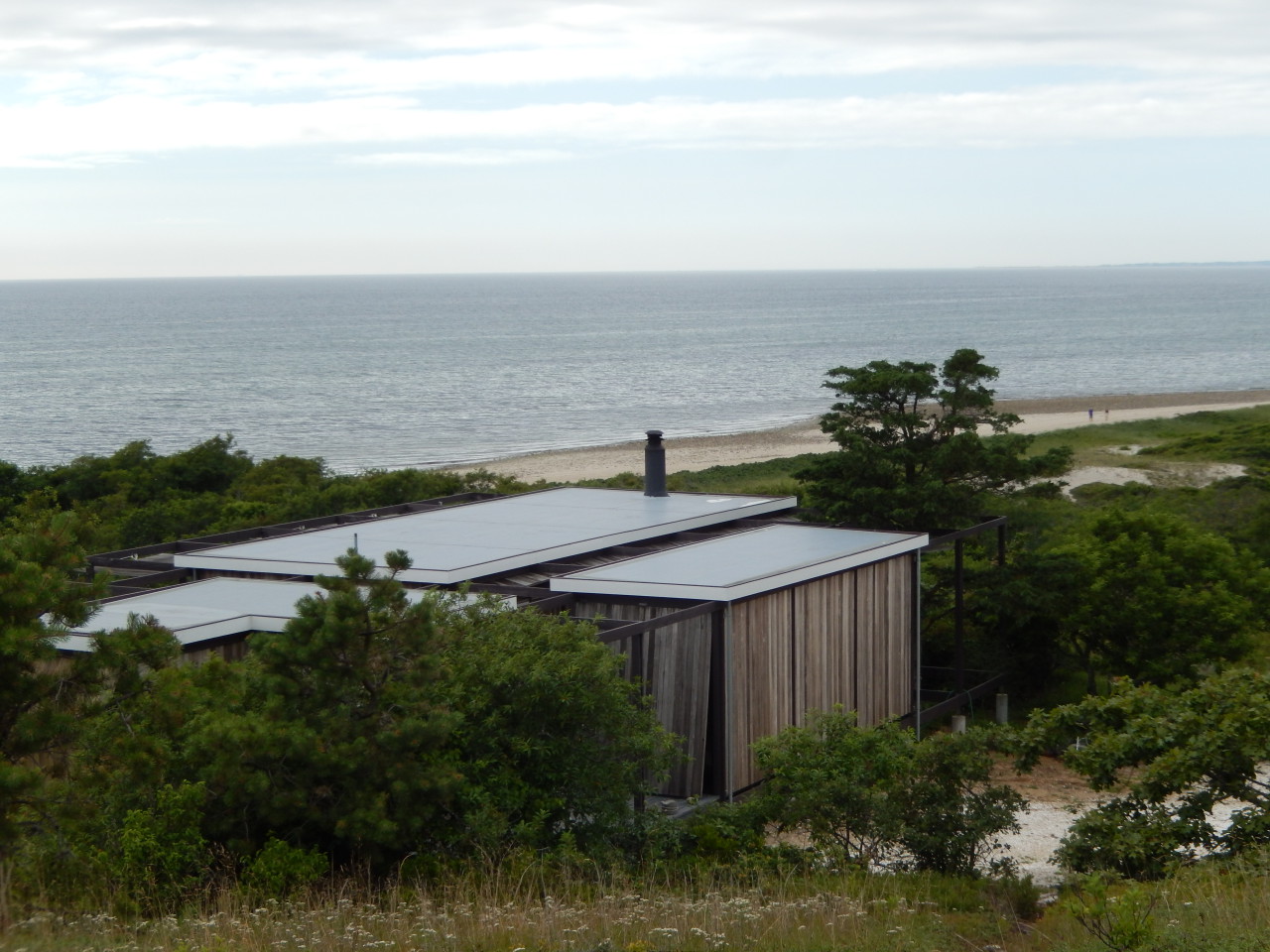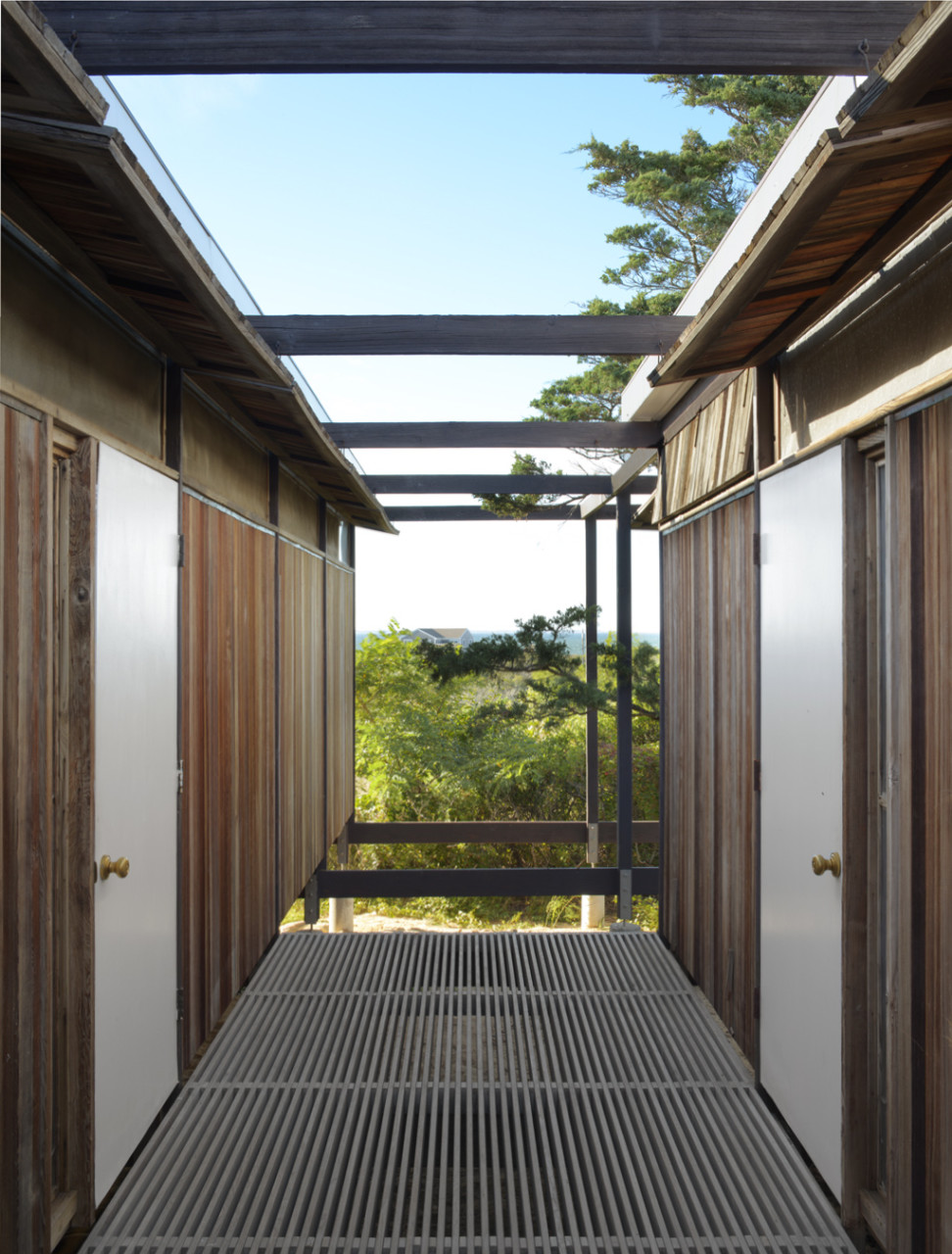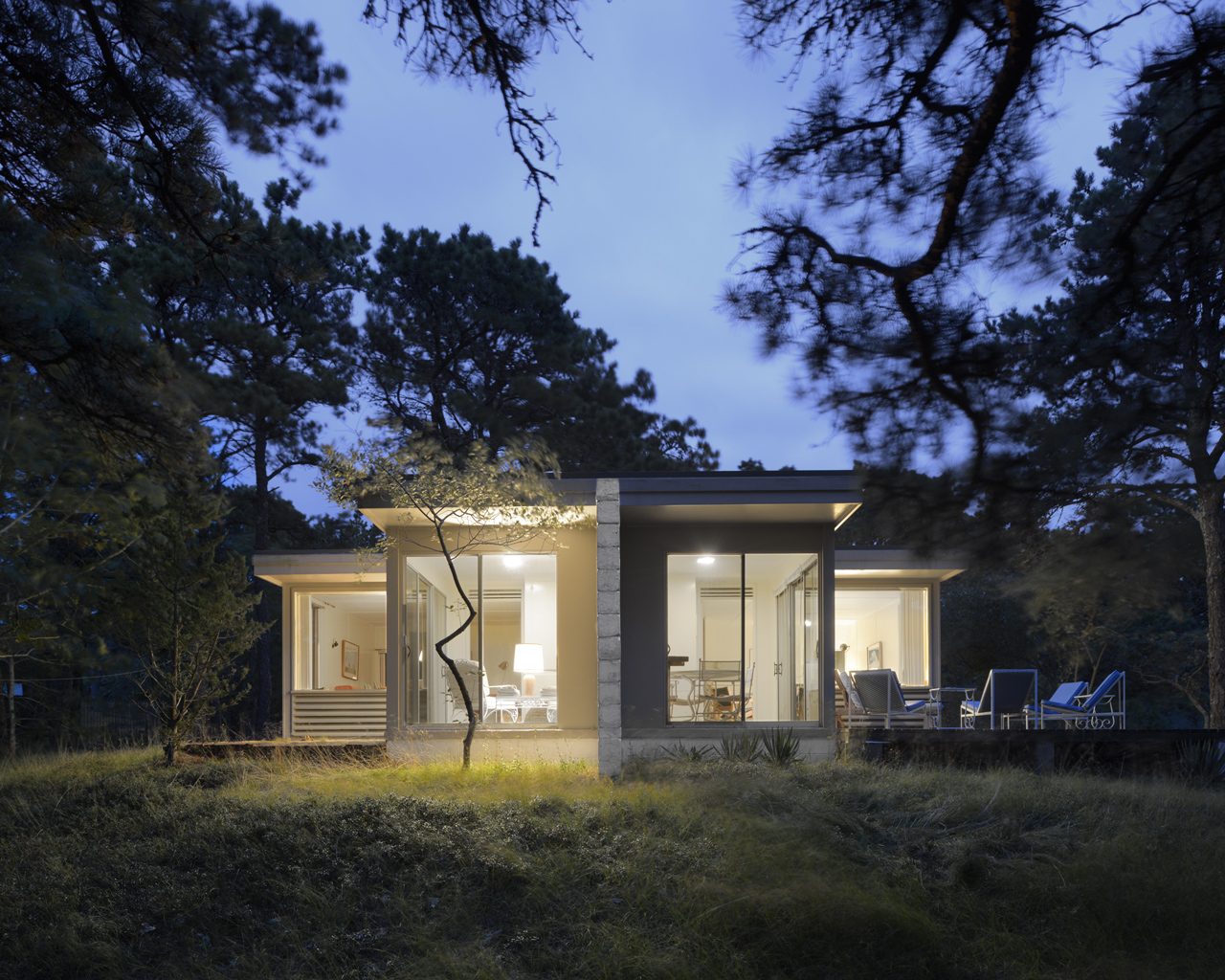Advertisement
'Cape Cod Modern' Tells The Story Of A Hidden Architectural Community
ResumeAt the end of a pitted dirt road in the woods of Wellfleet, Mass., you can smell the ocean. And perched on a grassy hill just above the dunes is the Hatch House. It's a low-slung modern home built with weather-beaten boards that seem to have grown from the Cape Cod landscape. It's simple and rustic, yet elegantly modern, with a porch that invites you out into the soft, summer air.
The Hatch House is an example of mid-century American modern architecture — one of about 100 such homes built on the Cape in the middle of the 20th century.
"I think these buildings are very free. The land was cheap, there were no building codes," says Peter McMahon. He's co-author of the new book, "Cape Cod Modern: Midcentury Architecture and Community on the Outer Cape." It tells the story of these modern homes and the extraordinary people who built them.
Christine Cipriani, who co-authored the book, says the homes were designed and built by two groups of people: first, a collection of largely self-taught Americans, who she refers to as "Brahmin Bohemians." Among them was a self-taught architect named Jack Phillips. Cipriani says Phillips inherited a large piece of land on the outer Cape and decided to try his hand at architecture.
"He put up a little studio, a kind of glass-walled, slant-roofed, shed-roofed studio on the Atlantic Ocean, which is the first place one would think of to build on the Cape," says Cipriani. "Eventually, it met an end because of its dramatic site, by being washed into the ocean. But it did live a long life of several decades of having artists paint there and also people kind of holding dance parties there. So, that was kind of the original, and in some ways the best kind of Cape modern building."
More Brahmin Bohemians came and built more buildings. They included Nathanial Saltonstall and Jack Hall, who designed the beautiful Hatch House.
"All of these gentlemen were well educated, from essentially affluent families, primed for professional backgrounds and — all in different ways — sort of forsook those careers to come out here and teach themselves architecture by doing these very experimental buildings in this very bucolic setting," says Cipriani. "The other group of people were the Europeans who were exemplified by Marcel Breuer, who studied at the Bauhaus and became a master of cabinetmaking at the Bauhaus. [He] came here with his original mentor, Walter Gropius, to teach at Harvard. And those groups found each other, socially, and became a loose but pretty happy community and eventually you had at least 100 modern houses of interest."

What drew them to the Cape is likely what draws all of us.
"The ocean, the light, the quiet," says Cipriani. "Except it was even quieter then than it is now — and quite a bit cheaper."
When you look at these houses, what's significant about them today is that they still feel so modern.
"There was no real prescription on them to do anything in particular," says McMahon. "So they would try all kinds of experimental things that had to do with combining high modern ideas with vernacular Cape architecture. So, all this group, the Americans and the Europeans, were very interested in the vernacular buildings... The oyster shacks, the little timber bridges and the old Cape houses. And there's this sort of duality in modernism in that all the modernists were very, very interested in 'primitive' art and architecture, or folk architecture, they liked its honesty. It was unpretentious, it was simple and functional and made with local material."
McMahon says Ruth Hatch lived in the Hatch House into November every year, even though there's no insulation and no heat of any kind. In other words, she was a hearty New Englander. She remained until she was 93 years old.
Hatch's paintings of the Cape Cod landscape still hang on the walls. As lovely as they are, it's the design of the house that is most striking. The living room is lovely and long, and looks out onto the porch and across the dunes to the ocean.

"[Architect Jack Hall] came up with this idea [in 1961] for this kind of modular semi-prefabricated building that was based on cubes," says McMahon. "So, these are seven by seven foot cubes. Still, today, it looks like a pretty radical idea, which is that you go outside to get to the other rooms."
The living room is made up of three of those cubes.

"I first found this house probably 15 years ago and it was all closed up because the shutters open and close," says McMahon. "So, the idea is you can adjust it with the weather — open and close it for ventilation and light. I couldn't tell if it was a house or if it was a storage shed for lobster pots or, I couldn't tell exactly what it was but it was a fascinating structure, so it has this kind of surreal relationship with the landscape, which is that it's hovering. The deck boards are vertically standing up and then there's this sort of beautiful siding of the building, so that you're floating above the landscape, perfectly situated to get all the views, but you're not exactly moored to the land. So, the idea with these buildings is that you could pick them up and there would be really almost no trace that the building had been there."
Of the 100 mid-century modern homes remaining on the Cape, some are privately owned. And some, like the Hatch House, are owned by a trust — inside the boundaries of what is the now the Cape Cod National Sea Shore. After the National Park was established, the government slated some of these buildings for demolition. But Peter McMahon established a trust in 2007 to save, renovate and preserve them — including the Hatch House — which is now available to the public to rent.
"They're important artifacts in and of themselves," says McMahon. "They're amazing pieces of architecture and they're important, historically. They're also important because of who lived here and what they did. This was a really vibrant community that produced a lot of really interesting ideas which came to fruition in the larger world."

"Now that this era has passed into history, we see it as important in two ways: it was an important chapter in the history of American modern architecture, but it's also an important little-known chapter in the history of Cape Cod, and just the history of New England," says Cipriani. "It was an art colony that was not known the way that Provincetown painters and actors were known and it's been exciting to try to bring that to light."
New houses are often grand, big and made with expensive materials. But these designs are simple.
"Bohemians that moved here — that first group that came, they did farming, they were fishing, and there was this kind of founding fathers sort of idea that you can do everything," says McMahon. "It reminded me of Ben Franklin a little bit in that they had this sort of can-do attitude. Often, with very, very little money — these houses often had like a $4,000 or $5,000 budget... I think there's a lot to learn from these buildings. I mean, they're green before green. Talk about a light footprint, they're almost not touching the ground... And they're very optimistic, I think. That's one reason people are attracted to mid-20th century modernism. It's a very optimistic kind of worldview. I find it very hopeful."
If not for McMahon's efforts — and the efforts of others — these houses might have just collapsed and gone into the dunes.
"There's a lot of challenges, in that they're very lightly constructed. And, sometimes, by amateurs. In the case of this house, the footings were all poured with beach sand, which has salt in it. So, they had all crumbled and fallen apart. It's a very unforgiving climate, and the buildings were, in some cases, almost temporary structures. So, the challenge is to restore the building without losing the patina and the idea behind the building."
"It's actually something we talk about in the early part of our book," says Cipriani. "The kind of ephemeral nature of so much architecture on Cape Cod. There's a history on the Cape of old buildings inhabited by artists for creative purposes that eventually find their way back into the water. It's almost as though artists are trying to fly too close to the sun because it's such bliss to be here on the water, kind of making your art. As we learned in our research, the Cape is destined to be around for about 5,000 more years, and it might be completely gone by then. So there's no sense of permanence and I think that's understood, but it just makes everything that much more thrilling."

Christine and Peter will be speaking as part of a panel discussion at the Wellfleet Public Library Friday.
Guests
Christine Cipriani, design writer and co-author of "Cape Cod Modern: Midcentury Architecture and Community on the Outer Cape." She tweets @christinecipri.
Peter McMahon, founding director of the Cape Cod Modern House Trust and co-author of "Cape Cod Modern: Midcentury Architecture and Community on the Outer Cape."
More
New York Magazine: Look Inside Cape Cod’s Hidden Modern Houses
- "When you think of Cape Cod architecture, you might call to mind shuttered, clapboard cottages with pitched roofs and gables — not the Bauhaus. But between the 1940s and '70s, Wellfleet was a hotbed of modern architecture, and home to some of the movement’s biggest names."
The Boston Globe: Modern Homes Build On Cape Traditions
- "Architecture on Cape Cod has always been imbued with this sense of impermanence. Every type of building here — domestic, commercial, maritime, holiday — has an element of the ephemeral."
- "Architects are a notoriously fussy bunch so when it comes to taking vacations, a package holiday with the madding crowds just won’t cut the mustard. Indeed as far from everyday folk as possible seems to be their main criteria which is why, in the mid-20th century, some of the world’s best-known architects took themselves to the Outer Cape."
This article was originally published on August 13, 2014.
This segment aired on August 13, 2014.